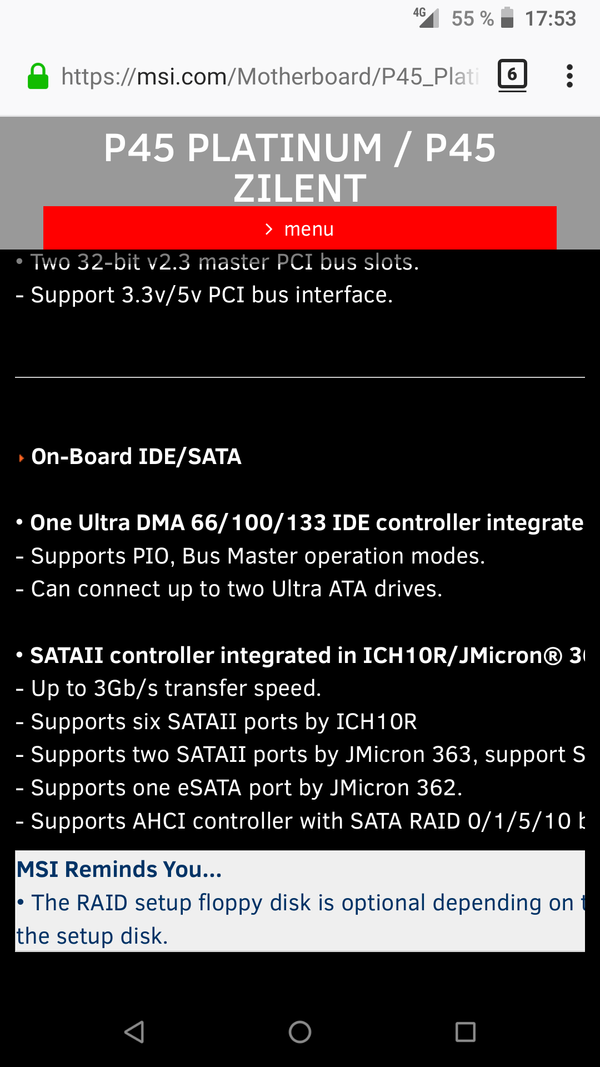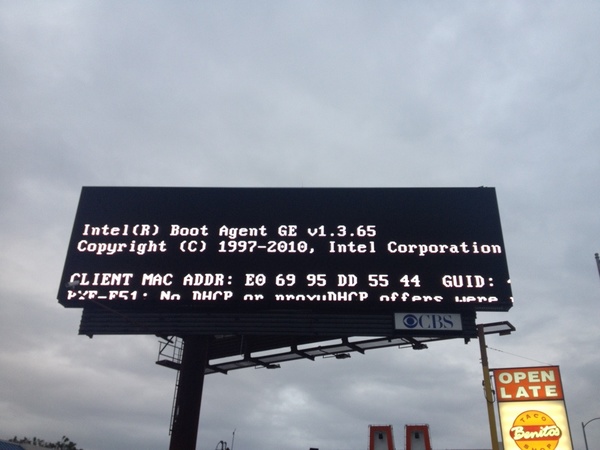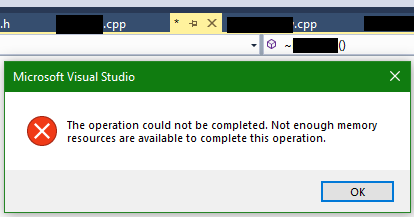WTF Bites
-
@pie_flavor said in WTF Bites:
Of course, if any 500-class error is being shown to the user without you explicitly causing it to happen, you're doing it wrong.
500-class errors shouldn't reach the user, but sometimes shit happens; they're a reflection of the fact that the code on the server isn't perfect (and often there isn't the budget for massive architectural resilience or exhaustive testing).
Given that, you can say that things have gone wrong and that it it's not the user's fault. That might be something of a lie sometimes, but it's not really; programmer shouldn't have let it get through. Still, there's no reason to ever give a stack trace. (There's also no need for them in a 400-class error, but there you might also want to not log the trace either; user requests being wrong occasionally is at least sort of expected.)
-
All my cleverness
Ah, I see. You simply needed to check for both cases: If one of your classes was mentioned, do your thing, otherwise, give back the full.
To this day I'm always frustrated when a missing null-check ends up stuffed into ntdll.dll or someshit like that and I can't get back to wherever it was in my code that had the problem...
-
@tsaukpaetra said in WTF Bites:
Ah, I see. You simply needed to check for both cases: If one of your classes was mentioned, do your thing, otherwise, give back the full.
Yes, but the scheme I was using (which was based on a pretty limited built-in filter) didn't let me do that. I suppose I could have written my own log filtering system, but I instead thought “fuck it, disk is cheaper than thinking” and kept the config simple instead.
-
@blakeyrat said in WTF Bites:
Again: why not? Why did they make that design decision? That's stupid.
As @Tsaukpaetra mentioned, you need to warp the image to make it useful for viewing through the HMD. That is, at the very minimum, you'd have to show the desktop image once for each eye (each eye is looking at a separate image in the HMD), and additionally warp it to account for the lenses in the HMD. (Essentially, warping the image in software allows the HMD to contain fewer lenses, making it cheaper and weight less. Or so I'm told.)
Since the whole HMD thing is rather new, Windows doesn't have that much (any?) built-in support for this.
As a side note: early Oculus devkits showed up as a single standard monitor. You'd occasionally get to see your desktop (or other stuff from your flat monitor) on them (due to screen duplication or whatever). That is, you'd see whatever random parts of the flat image ended up in the visible regions of the HMD, and without compensation for the lenses. It was a rather headache inducing experience. Even if you closed one eye, the distortion from the lenses made making anything sensible out somewhat difficult.
Nowadays they just make the HMD not advertise itself as standard monitor, so Windows will never put anything on it by default. Which, given how differently they function from a standard monitor, is a rather sensible choice.
-
@cvi So lazy.
-
-
@blakeyrat said in WTF Bites:
So lazy.
Who? Microsoft? Probably. (Aren't they pretending to be rather on top of the VR / "mixed reality" train, though?)
There are a couple of third party applications that can show you your desktop in VR. But last time I checked, all of them were limited to just showing your existing flat-monitor desktop(s) in VR -- apparently there is no way of convincing Windows to render itself into a virtual frame buffer only. So, yeah, I would think the ball is in Microsoft's court for this one.
-
@tsaukpaetra said in WTF Bites:
@pie_flavor said in WTF Bites:
GOD FUCKING DAMMIT WINDOWS.
Now I just need a setting "When should Windows show the lockscreen?" and have it set to "NEVER!!!"
Because apparently Windows will still lock the screen despite the screen timeout being never and no screensaver and no password on the account and literally every setting I can think of to stop it (this is my VR machine, which is headless and of course does not work if the lockscreen is showing).My media/vr/games computer does not ever show a lock screen. I've simply configured it to automatically log in with user "Games" and set it to never ever sleep once started. No screen savers, no lock screens or anything.
-
@blakeyrat said in WTF Bites:
@cvi So lazy.
Or smart. Because they're less likely to do something really stupid that people will come to rely on but then they can't ever take it out or they'll break backwards compatibility so everyone is stuck with something retarded forever.
Never count the
 out.
out.
-
@boomzilla Why is it retarded to assume something with screens in it plugged into a computer will display the computer's desktop on those screens?
I honestly didn't know that was the case, because I'm not a sucker with $700 to throw away on stupid fads. But now that I know it was, I'm sitting here going, "so wait what the fuck was Oculus even doing all this time?"
-
@blakeyrat said in WTF Bites:
Why is it retarded to assume something with screens in it plugged into a computer will display the computer's desktop on those screens?
Why are you putting words into my mouth you giant dickhead?
-
@boomzilla Because I'm satan and hitler rolled into one.
-
@blakeyrat You're not good enough to be Stalin!
-
don't drop hundreds of lines of stack trace on someone who has no power over resolving anything and who doesn't understand any bit of it. </soapbox>
Intern: this is fine
Junior Engineer: this is fine, because the end user can include these details in a bug report
Intermediate Engineer: We could log that error, and emit a reference number instead, which the user can included in their bug report
Senior Engineer: We could log that error, emit a unique reference number, and a specific error code, and automatically generate a support ticket (correlated with that error code), so we can be proactive about supporting our users
Manager: just don't write bugs
-
@blakeyrat said in WTF Bites:
I honestly didn't know that was the case, because I'm not a sucker with $700 to throw away on stupid fads.
pfff, you and your fiscal responsibility, and your months of salary saved up, and ability to own your own house.
-
@boomzilla said in WTF Bites:
@blakeyrat said in WTF Bites:
Why is it retarded to assume something with screens in it plugged into a computer will display the computer's desktop on those screens?
Why are you putting you giant dickhead into my mouth?
hawt
-
@lorne-kates said in WTF Bites:
pfff, you and your fiscal responsibility, and your months of salary saved up, and ability to own your own house.
(looks at the thread where he bought a $2700 cryptocurrency ASIC) ... ok sure why not.
-
So in the Nvidia thread wee found out the driver download page isn't responsive and disables horizontal scrolling. Today we find out that MSI has a responsive website, that responds in the wrong way and disables horizontal scrolling. Good job!


-
@tsaukpaetra said in WTF Bites:
@pie_flavor said in WTF Bites:
GOD FUCKING DAMMIT WINDOWS.
Now I just need a setting "When should Windows show the lockscreen?" and have it set to "NEVER!!!"
Because apparently Windows will still lock the screen despite the screen timeout being never and no screensaver and no password on the account and literally every setting I can think of to stop it (this is my VR machine, which is headless and of course does not work if the lockscreen is showing).My media/vr/games computer does not ever show a lock screen. I've simply configured it to automatically log in with user "Games" and set it to never ever sleep once started. No screen savers, no lock screens or anything.
Said here (except "Games" is a domain account)! But mine locks anyways.
-
@blakeyrat said in WTF Bites:
@boomzilla Why is it retarded to assume something with screens in it plugged into a computer will display the computer's desktop on those screens?

-
@blakeyrat said in WTF Bites:
I'm sitting here going, "so wait what the fuck was Oculus even doing all this time?"
I develop a product that's supposed to work with Oculus. I say that to myself nearly every day.
-
ActiveBoard doesn't know how to Date.

-

For a moment I thought they were talking about this one:
-

For a moment I thought they were talking about this one:
Eugh, amateur. Seriously? Moving the camera back and forth between the monitor and stack of disks? So distracting!
-
Please accept this cookie before seeing this screenshot:


-
Your passwords were securely hashed! But we kept unencrypted copies in a debug table and then lost that...oops
-
@cursorkeys said in WTF Bites:
But we kept encrypted copies in a debug table and then lost that...oops
Hah! As if!
From the Twitter support post:
We recently found a bug that stored passwords unmasked in an internal log.
-
@cursorkeys said in WTF Bites:
But we kept encrypted copies in a debug table and then lost that...oops
Hah! As if!
From the Twitter support post:
We recently found a bug that stored passwords unmasked in an internal log.
My
unfell off!
-
-
Visual Studio 2017 suddenly removed the filename of a source file tab. Hovering over it still showed the path, but I could no longer save changes to the file. When I tried to exit Visual Studio I got this message with 10+ gigs of unused RAM available...

And it won't let me exit...EDIT: I Ctrl+Z'd the changes until the asterisk went away and it decided to stop holding me hostage and finally exit.
-
TL;DR: I'm trying to build a heterogeneous cluster
So, I needed to bootstrap a model.
The model in question was written by my colleague as part of his PhD equivalent project. He was very much a beginner back when he'd started, so the code (written in "C with classes") isn't pleasant to read and occasionally contains gems, such as
sprintf(buf, "%s", rows[7]); if (stricmp(buf, "(null)")!=0) {to check for a
NULLpointer.On the other hand, it works (if you don't feed it physically wrong numbers), it describes the experimental data well, it's almost as fast as possible for us to make it (we'd profiled the code and then sped up everything we could, from usage of BLAS and FFT convolution to approximate Voigt profile function instead of true Lorentz*Gauss convolution which is slower) and, once I've written a nice OOP+RAII wrapper around it, the somewhat clumsy API (for historical reasons, some of the library internals are exposed in 7 different
structs you have to initialize, use and destroy at the same time) stopped bothering me, too.Now, bootstrap is just running statistics on results of lots of slightly different computations, so I could slightly modify existing code to implement sampling with replacement by means of weighted regression and run it a lot of times, and none of this would have to happen. I would even still be able to run tasks in parallel. But it wouldn't be WTF-worthy enough, and I, being an undergrad, wanted to exercise my holy right to do stupid stuff and get away with it.
We do have a lab server (Windows HPC Server 2008). While doing an unrelated project a few months ago I had found out that if you install Cygwin SSH server on it and whack at it with a wrench, the
parallelR package becomes able to spawn workers on both your laptop and the lab server and use them to restart alternating least squares, for example.
The server is also the desktop of another colleague, so I was allowed to use three cores out of four, unless he's doing something really important. Suddenly another machine was given back to us by a person who was leaving the faculty. We examined it and found it to be exempt of dust and any usage whatsoever (the only thing we found on the harddrive was an empty Windows 7 installation that couldn't boot itself and the newest timestamps were in 2016). By then it was inevitable: my decision to build a Beowulf-like cluster has crystallized and I was not going to be talked out of it.There were just two problems: (1) we had no spare wireless cards or spare Ethernet jacks in the lab router and (2) the cluster had to consist of a Linux laptop, a Windows lab server (no admin rights on that one) and of whatever I run on the empty 2016 machine. (1) gets a WTF-worthy solution right away: I use the previously unused Ethernet
socket of my laptop to netboot Debian on the 2016 machine and provide Internet access to it, as well. It goes surprisingly well. Despite full interconnectedness never being achieved because of NAT (I decided not to bring the WTF factor up to 11 by trying to bridge wlan and ethernet interfaces), I only need all machines to be able to connect to rank 0, which is my laptop, anyway. As for (2)... Well, presumably, Intel MPI is a good cross-platform implementation that officially supports running different OSes at the same time, but it costs money and has no free option for academia people (unlike MKL or Fortran compiler). And that's fair: if you've just shelled out big $$$ for computing-grade hardware, another $500 for software shouldn't be much of a problem. But since I didn't have the equivalent of ~150 university lunches handy, my only options were free options. As far as they go, MPICH doesn't support Windows at all (despite MS-MPI and Intel MPI being based on it) and OpenMPI only supports Windows through Cygwin. Well, I already have Cygwin installed, so it should be easy! (I thought.) Clickety-click, I installlibopenmpi-dev openmpi-binon the Linux side of things andlibopenmpi-devel openmpion Cygwin and quickly discover that OpenMPI 1.10 won't talk to OpenMPI 2.0 no matter what.I spent some time trying to compile OpenMPI 2.0 on Cygwin, but it was clearly not intended to happen: once I stumbled through Cygwin POSIX-like sockets conflicting with Winsock (because something
#define'dWIN32which is normally not defined on Cygwin; I couldn't figure it out and just added#undef WIN32to some of the header files), I landed in OpenMPI trying to calldlsymwithRTLD_NEXT(which is not implemented at all; I ended up replacing the call withNULL) and in the end it just didn't work (I'm not sure I even got to the point where mpirun would start tasks locally). Compiling OpenMPI 1.10 on Linux was uneventful by comparison and I even got some sample programs working cross-OS (sending anMPI_LONGfrom Windows to Linux was an educating experience, though), but it always took a while to start up (the lab server must have been trying to use the unrouteable address of Ethernet card first to connect back to my laptop), sometimes mysteriously hung in the middle of computation and eventually stopped working at all (just hung forever atmpirunstartup). By this time I'd lost much more time debuggering all this than I would've spent if I just ran./fit_model_once experimental_spectrum.txt settings.ini10000 times, but the really cool (for an undergrad) 176-line C++ template-based worker queue implementation in MPI wouldn't use itself, so I gave up on the idea of using the lab server and focused on the two computers I had under my (mostly) total control. Besides, the giant weekend formed from the ordinary weekend glued together to double-holiday International Workers' Day was approaching, so instead of the lab server I was given the opportunity to build a cluster from some desktops I have at home.Netboot over 2.4GHz Wi-Fi (because my laptop is still the server and I'm too lazy to walk over to the access point on top of a cabinet and plug it in) in a house crowded with flats and other 2.4GHz access points doesn't work great, but if you don't do lots of disk I/O (the model does require network access to
SELECT(queries are built using string concatenation, naturally) atomic line parameters from MySQL instance on the lab server, but normally doesn't create any files), eventually it fills the caches and works fine.At that point the whole thing started working, although not the way I originally intended it to be, so there's no ending, sorry.
-
so there's no ending, sorry.
I bet you would have gotten it working better if you had indeed bridged the Wi-Fi and Ethernet in your laptop.

-
-
I opened Visual Studio Code's settings. Rather than get a settings window, it opens a JSON text file thing with the preferences

WTF?! I thought blakeyrat was just exaggerating, but no, Microsoft has gone full retard and joined the "TEXT FILES ARE THE BEST UI" cult.
But what makes it an order of magnitude worse is, it's not actually a text file. You still have to click in the individual settings and it shows a menu with the possible values. So it's all the work of making a GUI with all the niceness of a text file.
-

-

No, bitch, I don't care what your Privacy Policy says, I won't give you my mobile number. Email works just fine.
-
@lolwhat I have older family members who don't even have cell phones or email addresses. This type of stuff is making it impossible for them to do things.
One got turned away at something (I don't even recall what, might have been a bank account or mail-in shopping order or something) because she was filling out a paper form and they wouldn't accept it without an email address or cell number.

-
A total of eight new security flaws in Intel CPUs have already been reported to the manufacturer by several teams of researchers...
Intel itself classifies four of the Spectre-NG vulnerabilities as "high risk"; the remaining four are rated as "medium". According to our own research, risks and attack scenarios at Spectre-NG are similar to those at Spectre – with one exception.
One of the Spectre-NG flaws simplifies attacks across system boundaries to such an extent that we estimate the threat potential to be significantly higher than with Spectre. Specifically, an attacker could launch exploit code in a virtual machine (VM) and attack the host system from there – the server of a cloud hoster, for example. Alternatively, it could attack the VMs of other customers running on the same server. Passwords and secret keys for secure data transmission are highly sought-after targets on cloud systems and are acutely endangered by this gap. Intel's Software Guard Extensions (SGX), which are designed to protect sensitive data on cloud servers, are also not Spectre-safe.
Although attacks on other VMs or the host system were already possible in principle with Spectre, the real-world implementation required so much prior knowledge that it was extremely difficult. However, the aforementioned Spectre-NG vulnerability can be exploited quite easily for attacks across system boundaries, elevating the threat potential to a new level...
-
"Spectre Next Generation" is just around the corner.
Oh boy! I hope it has better graphics than my previous Spectre 1.
-
Status: I'm actually wondering if Spectre mitigation is what's suddenly causing the perforce server daemon to randomly choke and die, claiming the database files are corrupt (when they're really not at all), between requests for things like
fstatanduser-login....
-
When clueless marketing droids find a new trend:
-
@dcoder Um actually the most secure password is "Nutella horse stapler correct"
-
the most secure password is "Nutella horse stapler correct"
You have some strange words in your heart
-
@magus said in In other news today...:
@atazhaia Unrelated except by company:

"If you don't watch out, your driver could just vanish from under you!"
-
@timebandit said in WTF Bites:
the most secure password is "Nutella horse stapler correct"
You have some strange words in your heart
And his horse has Nutella stapled to it.
-
WTF Status: Really getting tired of this workflow, specifically the bolded section:
- Click "Build Project"
- Wait for project to build
- Click "Debug Project"
- Visual Studio error: "Project has not been built. Build now?"
- Click "Yes"
- Wait for project to build
- Finally debug
-
WTF Status: Really getting tired of this workflow, specifically the bolded section:
- Click "Build Project"
- Wait for project to build
- Click "Debug Project"
- Visual Studio error: "Project has not been built. Build now?"
- Click "Yes"
- Wait for project to build
- Finally debug
Dependencies not being set?
I know this happens in UE4 when you try to launch the game for the first time without building the shader compiler tool thing (which should be compiled already WTF).
-
WTF Status: Really getting tired of this workflow, specifically the bolded section:
- Click "Build Project"
- Wait for project to build
- Click "Debug Project"
- Visual Studio error: "Project has not been built. Build now?"
- Click "Yes"
- Wait for project to build
- Finally debug
Why don't you just skip steps 1 & 2

-
@mott555 Is the project you're building the same as the one you're debugging?
If your Solution didn't correctly identify the build dependencies, you can manually input them by right-clicking and picking "Project Dependencies".
-
@timebandit Same issue for some reason. It requires me to build the project twice before I can debug it. Even if I let it build on its own by clicking debug.



 Nvidia GeForce Windows driver bug: New hotfix issued to cure endless install loops
Nvidia GeForce Windows driver bug: New hotfix issued to cure endless install loops
